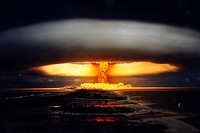
With the water release, Fukushima is overwhelmed again
What led to the Fukushima water release, and what are the impacts of one of the most controversial decisions of the post-nuclear disaster clean-up effort?
What led to the Fukushima water release, and what are the impacts of one of the most controversial decisions of the post-nuclear disaster clean-up effort?
“None of the information from the government and TEPCO should be trusted unless it’s independently verified,” says Safecast’s Azby Brown. We discuss what lies behind Japan’s decision to release radioactive water into the ocean with the researcher and transparency advocate.
A group of experts in Tokyo suggested pouring radioactive water from Fukushima into the open sea. A marine biochemist explains the consequences of this absurd decision.
Ten years have passed since the 11 March 2011 disaster, but this chapter is far from over. Travelling through Fukushima, renewal and destruction can be seen side by side, sometimes separated only by a road.
More than 50 years after testing nuclear weapons in Polynesia, the French government has finally come clean regarding its harmful effects on the local population’s health.
The first one megawatt solar power plant in the Chernobyl exclusion zone has become operational. This is the first step in a renewable energy development project promoted by the Ukrainian government in the area.
The scene isn’t post-apocalyptic as one might expect. Fukushima, now, seems like any other place – underpopulated but ordinary. In 2016 we visited the prefecture on the northeastern coast of Japan, over 200 kilometres north of the capital Tokyo, to talk to those who are committed to getting their lives back on track after the earthquake, tsunami
The day focuses on the need to stop nuclear tests, a threat that could lead to the extinction of our species.
Watch the video reportage produced by LifeGate A journey through Fukushima to meet farmers, food producers and restauranteurs five years after the earthquake, tsunami and nuclear disaster that shook Japan in March of 2011. Instead of desperation and abandonment, what characterises the prefecture is a community of motivated, resourceful and committed people ready to get back on their feet.
La centrale nucleare di Diablo Canyon chiuderà nel giro di dieci anni. Decisione presa grazie alla crescita delle rinnovabili e dell’efficienza energetica.








